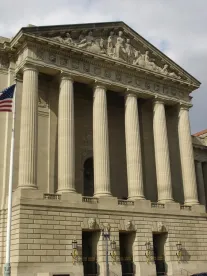On April 6, 2022, the United States Environmental Protection Agency (EPA) published a proposed rule in the Federal Register that would build on its existing Cross-State Air Pollution Rule (CSAPR) program by limiting further the emission of nitrogen oxides (NOx) from stationary sources located in 26 states. 87 Fed. Reg. 20,036 (Apr, 6, 2022). The proposal would implement EPA’s 2015 National Ambient Air Quality Standards (NAAQS) for ozone of 70 parts per billion by imposing Federal Implementation Plans (FIPs) on specified states pursuant to its authority under the “good neighbor” requirements of section 110(a)(2)(D)(i)(I) of the Clean Air Act. This provision requires upwind states to prevent sources located within their borders from contributing significantly to nonattainment or interfering with maintenance of the NAAQS in downwind states.
EPA’s existing CSAPR ozone-season NOx program limits NOx emissions from fossil fuel-fired electric generating units (EGUs) in 22 states during the ozone season, which runs from May 1 through September 30. In the proposed rule, EPA applies the same basic four-step process that it developed and used in previous CSAPR rulemakings, which we have described in a previous post. The proposed rule deviates from EPA’s previous methodology in certain important ways, however, which results in a proposal that is groundbreaking. First, the proposed rule would limit NOx emissions from certain industrial stationary sources (referred to as “non-EGUs” in the proposed rule), whereas previous CSAPR rules have only regulated emissions from EGUs. Second, the proposed rule would include western states, including California, Nevada, Utah, and Wyoming, which were outside the modeling domain used in previous CSAPR rules. Finally, the proposed rule would include key features for the EGU portion of the program that were not included in EPA’s previous transport rules. These features include dynamic adjustments of emission budgets beginning with ozone-season 2025 and backstop daily emission rates for most EGUs. The proposed rule would impose ozone-season emission budgets on EGUs in covered states beginning in 2023, and on non-EGUs beginning in 2026.
The 26 states included in the proposed rule are Alabama, Arkansas, California, Delaware, Illinois, Indiana, Kentucky, Louisiana, Maryland, Michigan, Minnesota, Mississippi, Missouri, Nevada, New Jersey, New York, Ohio, Oklahoma, Pennsylvania, Tennessee, Texas, Utah, Virginia, West Virginia, Wisconsin, and Wyoming. The FIPs for most of the 26 states would limit NOx emissions from both EGU and non-EGU sources; FIPs for two states – Alabama and Tennessee – would limit emissions from EGUs only, and the FIP for California would limit emissions from non-EGUs only. A map depicting the geographic coverage of the proposed rule is available on EPA’s website.
The EGU Program
The EGU program would establish caps on EGU NOx emissions in 25 of the 26 states included in the proposed rule – all except for California – beginning with the 2023 ozone season. The proposed rule explains that the 2023 compliance date is timed to require emission reductions before the August 3, 2024 ozone attainment date for areas classified as Moderate nonattainment for the 2015 ozone NAAQS. The proposed rule also explains that the proposed 2023 emission budgets for EGUs reflect emission reductions that EPA’s modeling projects are achievable through immediately available measures, including full operation of existing post-combustion emission control equipment, both selective catalytic reduction (SCR) and selective non-catalytic reduction (SNCR) controls, as well as state-of-the-art combustion control upgrades.
Additional decreases in NOx emissions from EGUs would be required in 22 of these states beginning with the 2026 ozone season, which EPA notes would occur prior to the August 3, 2027 attainment date for areas classified as Serious nonattainment for the 2015 NAAQS. The states in which these further emission reductions would be required are Arkansas, Illinois, Indiana, Kentucky, Louisiana, Maryland, Michigan, Minnesota, Mississippi, Missouri, Nevada, New Jersey, New York, Ohio, Oklahoma, Pennsylvania, Texas, Utah, Virginia, West Virginia, Wisconsin, and Wyoming. The proposed rule explains that the proposed 2026 emission budgets for EGUs reflect emission reductions that EPA’s modeling projects are achievable through installation of new post-combustion emission control equipment, including (1) retrofitting coal-fired EGUs with a capacity of 100 MW or greater, except those with circulating fluidized beds (CFB), with new SCR; (2) retrofitting coal-fired units with a capacity less than 100 MW and those with CFB with new SNCR; and (3) retrofitting oil- and gas-fired units with a capacity greater than 100 MW that have historically emitted at least 150 tons of NOx in an ozone season with SCR.
The proposed rule would create a revised version of the CSAPR ozone-season NOx trading program that would include EGUs in states receiving EGU emission budgets through the new rule. If the geographic scope of the final rule is the same as the proposed rule, this new “Group 3” trading program would include the 25 states identified in the proposed rule as receiving EGU emission budgets (all states except California), and Iowa and Kansas – which are part of the existing CSAPR ozone-season trading program but would not receive amended ozone-season NOx budgets under the proposed rule. Iowa and Kansas would remain subject to the existing program, but would not be part of the new one. EPA proposes to recalibrate the number of banked allowances held in all Allowance Management System accounts annually to reduce the ability of EGU owners to comply with their budgets through allowance banking and trading.
As noted previously, the proposed rule would introduce significant modifications to the existing CSAPR program for EGUs, including (i) “dynamic” emission budgets that would be subject to change from year to year beginning with the 2025 ozone season, and (ii) imposition of a backstop daily emission rate of 0.14 lb/mmBtu for coal-fired steam units serving generators with nameplate capacity greater than or equal to 100 MW. The backstop daily emission rate would first apply in 2024 for units with existing SCR controls, and in 2027 for units currently without SCR controls. To implement the proposed dynamic emission budgets, the proposed rule provides “preset” state ozone-season NOx budgets for EGUs in 2023 and 2024, and explains that state budgets for later years (beginning with the 2025 ozone season) would be set in the year before the control period, based on the latest information available on the composition and utilization of the EGU fleet at the time the emission budgets are determined. The proposed rule, therefore, provides only “illustrative” emission budgets for the control periods in 2025 and 2026. EPA asserts that these new features, together with the limitations on allowance banking and trading, “would protect the intended stringency of the trading program against potential erosion caused by EGU fleet turnover and would better sustain over time the incentives created by the trading program to apply continuously the degree of emissions control the EPA determines is necessary to address states’ good neighbor obligations.” 87 Fed. Reg. at 20,105.
The Program for Industrial Stationary Sources
This proposal marks the first time that EPA proposes to impose emission budgets on sources other than EGUs pursuant to its authority under the good neighbor provision. EPA proposes to establish limits on NOx emissions from the following industrial sources:
-
Reciprocating internal combustion engine in pipeline transportation of natural gas;
-
Kilns in cement and cement product manufacturing;
-
Boilers and furnaces in iron and steel mills and ferroalloy manufacturing;
-
Furnaces in glass and glass product manufacturing; and
-
High-emitting equipment and large boilers in –
-
Basic chemical manufacturing,
-
Petroleum and coal product manufacturing, and
-
Pulp, paper, and paperboard mills.
-
EPA identifies specific control requirements for each listed source type. The proposal indicates that EPA determined the industries subject to new control requirements and the controls required through consideration of air quality modeling, information on annual emissions, and information about the projected efficacy of available controls in providing air quality improvements at key downwind sites. In making these determinations, EPA imposed a marginal cost threshold of $7,500 per ton on control options.
EPA proposes to mandate that the specified controls be implemented for new and existing sources of the types listed above in 23 states by 2026. These states are Arkansas, California, Illinois, Indiana, Kentucky, Louisiana, Maryland, Michigan, Minnesota, Mississippi, Missouri, Nevada, New Jersey, New York, Ohio, Oklahoma, Pennsylvania, Texas, Utah, Virginia, West Virginia, Wisconsin, and Wyoming. Operation of the controls would be required during the ozone season. Unlike the EGU program, no trading program is proposed for emissions from industrial sources.
EPA will hold a virtual public hearing on the proposal on April 21, 2022, and will accept public comment on it through June 6, 2022.





 />i
/>i
